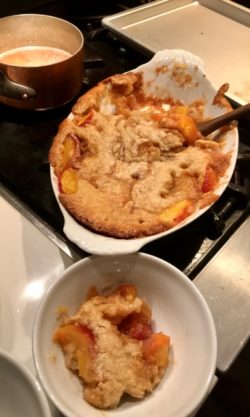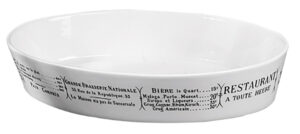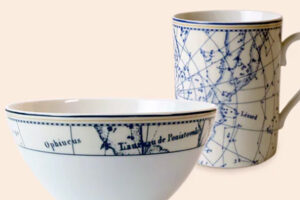Pillivuyt refers to these elongated “Plisse” serving plates as tapas dishes. But clearly they make for a nice presentation of other things. / Pillivuyt photo. On the front: Blueberry Streusel Muffins baked in Pillivuyt molds by Cloudy Kitchen, a blog from Erin Clarkson.
By Nancy Pollard
After owning one of the best cooking stores in the US for 47 years—La Cuisine: The Cook’s Resource in Alexandria, Virginia—Nancy Pollard writes Kitchen Detail, a blog about food in all its aspects—recipes, film, books, travel, superior sources, and food-related issues.

 ONE OF THE cookware collections I accrued over the small space of 47 years at La Cuisine was quite a variety of culinary porcelain: France, Germany, China, USA were all well represented. There was a period when Nils, our video genius (and chicken wrangler), and I were on a quest to re-create the best clafouti (we both had a memory of eating an absolutely sublime one at different times and were trying to re-create it). We are still looking for the dream recipe, but one thing became clear: Out of all the brands of porcelain that we baked with, the one that soared above the others was Pillivuyt. Not just for clafouti experiments, but also for soufflé recipes, potato gratins, fruit cobblers, and assorted experiments from cooking websites. And in France, when visiting restaurants, I would surreptitiously turn over a plate to find out who the manufacturer was. More often than not, it was Pillivuyt.
ONE OF THE cookware collections I accrued over the small space of 47 years at La Cuisine was quite a variety of culinary porcelain: France, Germany, China, USA were all well represented. There was a period when Nils, our video genius (and chicken wrangler), and I were on a quest to re-create the best clafouti (we both had a memory of eating an absolutely sublime one at different times and were trying to re-create it). We are still looking for the dream recipe, but one thing became clear: Out of all the brands of porcelain that we baked with, the one that soared above the others was Pillivuyt. Not just for clafouti experiments, but also for soufflé recipes, potato gratins, fruit cobblers, and assorted experiments from cooking websites. And in France, when visiting restaurants, I would surreptitiously turn over a plate to find out who the manufacturer was. More often than not, it was Pillivuyt.
Not only does it cook beautifully, but it also cleans easily (this from the Chief Dishwasher). Crusts form evenly, not too thick or overdone at the edges, and centers stay creamy. Looking at my assortment of platters, dishes, and bakers, the Pillivuyt examples have cleaner design details, crisper edges, and in some cases, are much less clunky to hold or pull out of the oven than their competitors. They hold up better, I think, over a long period of use and time too.
A Porcelain History Lesson
Pillivuyt is one of the few porcelain manufacturers to develop its own porcelain compounds on site at the factory in Berry, France, and it has done so for almost 200 years. The founding Pillivuyt brothers were actually Swiss; Charles and Jean Louis bought a brick factory in 1818 in Foëcy but determined they wanted to produce culinary and table porcelain for households instead. This location was ideal for its neighboring forests and water, and the proximity to Limoges, where kaolin deposits had been recently uncovered. When this natural resource was discovered, Europeans had found the secret ingredient required to create porcelain, after coveting a material that had been exclusive to China for over 300 years.
The porcelain business remained in the Pillivuyt family for over 127 years. There were reversals of fortune and family squabbles, and another factory was founded by a descendant, Albert Pillivuyt, which had the trademark “Apilco.” Apilco itself was bought in 1980 by the Deshoulières Group, which owns Porcelaine de Sologne and Deshoulières. Alfred Simon purchased the brand in 1945 and took over as General Manager, implementing the latest technologies and manufacturing processes. These changes improved uniformity and productivity, while the technique for creating superior porcelain wares remained much the same.
Their production was and is 100% French—none of it is subcontracted to other countries. This is actually an issue with a lot of companies that want to maintain a “Made in . . .” identity. Parts get farmed out to low-bidder factories in other countries, then shipped to the manufacturer where they are assembled and stamped Made in France, or Made in Germany or Made in USA.
You can find pieces of Pillivuyt history on many websites dealing with antiques. They made custom dinnerware and game terrines. I bought their classic soup tureen with an orange and black stripe along with soup spoons with matching handles. And even now, they come up with some astounding designs, as you can see in the photo of their Canope presentation plate. One of their designs was conceived specifically for use in hospitals and assisted-care facilities, with non-slip silicone bases, double-handled cups, and high-lipped plates for ease of use by weak or unsteady hands.
Some Science Behind Pillivuyt
We wondered why Pillivuyt pieces lasted longer in my kitchen than its competitors. First, their casting starts with hand-made prototypes in plaster built according to precise computer models. Second, the firing process involves more than 10 steps, which take several days or weeks to complete. The factory fires their pieces first at 1795F, then the glaze is applied before a second firing at 2552F, which is higher than the heat of several of its competitors. Decorated pieces are fired a third time so that they become impervious to changing color or fading. Lower-quality porcelain is fired at a much lower temperature, especially when cadmium and lead are part of the clay mixture. Pillivuyt, along with the Apilco and Revol brands, follow the Prop 65 protocols. Lesser competitors cannot make the same claim. Pillivuyt won the Innovation Reward for their development in 2005 of Pillienium, a stronger and thinner “paste,” which can be made into cookware and service pieces that are more versatile and have greater aesthetic appeal. Multiple firings at high temperatures are not inexpensive, but the end product is non-porous and highly resistant to mechanical and thermal shocks.
All their porcelain is safe in the freezer, microwave, and dishwasher. Your Pillivuyt cookware can be transferred directly from freezer to oven.





I have several Pillivuyt pieces from my late mother-in-law, who was a tremendous cook, and also a collector of fine things. They have to be close to ancient at this point, but are still beautiful to look at and a pleasure to use. Thanks for the history lesson.